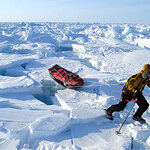Paleontology

Alan Hubert and Dixie Dansercoer collect snow-depth data for ESA's CryoSat-2 mission. They're seasoned polar explorers so they are used to dealing with physically demanding and downright harsh conditions but what they encountered during their three and a half-month expedition from Russia to Greenland via the North Pole was dangerous even for them.
They didn't expect that the Lincoln Sea in the Arctic Ocean, the very ice they were on, would begin to disintegrate. Aside from the dangerous conditions they also had to circumnavigate the ice-free water leads.
Satellite video of the Lincoln…

Cracks in the icy surface of Saturn's moon Enceladus open and close daily under the pull of Saturn's gravity, according to new calculations by NASA-sponsored researchers.
"Tides generated by Saturn's gravity could control the timing of eruptions from cracks in the southern hemisphere of Enceladus," said Dr. Terry Hurford of NASA's Goddard Space Flight Center, Greenbelt, Md. Hurford is lead author of a paper on this research appearing in Nature May 17.
In 2005, the Cassini spacecraft flew by Enceladus and saw plumes of material erupting from the south pole of Enceladus. Scientists were…
Coral reefs, like tree rings, are natural archives of climate change. But oceanic corals also provide a faithful account of how people make use of land through history, says Robert B. Dunbar of Stanford University.
In a study published in the Feb. 22 issue of Geophysical Research Letters, Dunbar and his colleagues used coral samples from the Indian Ocean to create a 300-year record of soil erosion in Kenya, the longest land-use archive ever obtained in corals. A chemical analysis of the corals revealed that Kenya has been losing valuable topsoil since the early 1900s, when British settlers…

Scientists using NASA satellite data have found strong evidence that a major earthquake can lead to a nearly immediate increase in regional volcanic activity.
The intensity of two ongoing volcanic eruptions on Indonesia’s Java Island increased sharply three days following a powerful, 6.4-magnitude earthquake on the island in May 2006. The increased volcanic activity persisted for about nine days.
"During this period, we found clear evidence that the earthquake caused both volcanoes to release greater amounts of heat, and lava emission surged to two to three times higher than prior to the…

Geophysicists at the University of Rochester announce in today’s issue of Nature that the Earth’s magnetic field was nearly as strong 3.2 billion years ago as it is today.
The findings, which are contrary to previous studies, suggest that even in its earliest stages the Earth was already well protected from the solar wind, which can strip away a planet’s atmosphere and bathe its surface in lethal radiation.
“The intensity of the ancient magnetic field was very similar to today’s intensity,” says John Tarduno, professor of geophysics in the Department of Earth and Environmental Sciences at…

The story of some violent historic earthquakes may need to be revisited, according to a study published in the April issue of the Bulletin of the Seismological Society of America (BSSA). Seismologists rely on written accounts, mostly local newspaper articles, to judge how strongly the ground shook during earthquakes that predate the use of current instrumentation. Those news accounts have proven to be misleading, say scientists, and reliance upon them must be tempered when evaluating the size of past earthquakes.
By focusing on the most dramatic damage and other effects of an earthquake,…

Sandia National Laboratories researchers Mark Ivey and Bernie Zak are members of a research team from around the world whose work on the cold tundra in northern Alaska is helping to transform scientists' understanding of what the future may hold for Earth's climate.
The team conducts research at the North Slope of Alaska east of Barrow along the coast of the Chukchi Sea.
Instrument clusters near Barrow, Alaska, gather data useful in refining global climate models. (Photo by Mark Ivey)
Sponsored by DOE's Office of Science and managed by its Office of Biological and Environmental Research,…

Identification of the oldest preserved pieces of Earth's crust in southern Greenland has provided evidence of active plate tectonics as early as 3.8 billion years ago, according to a report by an international team of geoscientists in the March 23 edition of Science magazine.
The finding pushes back the date of continent-forming processes previously determined as 2.5 billion years ago to a much earlier era considerably closer to Earth's formation some 4.5 billion years ago. Geochemical analysis of rocks has previously suggested an earlier date for plate tectonics, but this is the first…

An international team of American and Chinese paleontologists has discovered a new species of mammal that lived 125 million years ago during the Mesozoic Era, in what is now the Hebei Province in China. The new mammal, documented in the March 15 issue of Nature, provides first-hand evidence of early evolution of the mammalian middle ear--one of the most important features for all modern mammals.
Named Yanoconodon allini after the Yan Mountains in Hebei, the fossil was unearthed in the fossil-rich beds of the Yixian Formation and is the first Mesozoic mammal recovered from Hebei. The…
Snail-racing is an action-packed spectator sport compared to watching the drift of Earth’s continents, which usually move just a few centimetres a year – about as fast as fingernails grow. But occasionally events quicken dramatically, and become interesting enough for a "desk-bound geophysicist" like Dr Tim Wright to pack his bags and go camel-trekking across a desert.
"What’s happening in the Afar region of northern Ethiopia is unprecedented," says the University of Leeds researcher. "A 60-kilometre long rift opened up there in just a couple of weeks. In fact some of the faults that slipped…